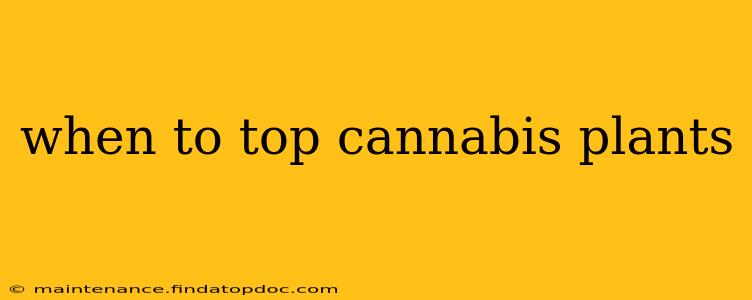Topping cannabis plants is a crucial horticultural technique employed by cultivators to increase yields and improve the overall structure of their plants. This involves removing the topmost set of leaves and the apical bud, the main growing tip responsible for vertical growth. Knowing precisely when to top your cannabis plants is vital for maximizing its benefits and avoiding potential setbacks. This comprehensive guide will equip you with the knowledge to make informed decisions about topping your plants for optimal results.
What is Topping and Why Do It?
Topping redirects the plant's energy from a single, dominant cola (the central bud) to several smaller colas, resulting in a bushier plant with multiple budding sites. This translates to a significantly larger overall yield compared to an untopped plant. The process encourages lateral growth, creating a more even canopy and better light penetration throughout the plant.
When is the Best Time to Top Cannabis Plants?
The optimal time to top your cannabis plants is during the vegetative stage, typically when the plant has developed 4-6 nodes. A node is the point on the stem where a branch or leaf grows. Waiting until this stage ensures the plant has established a strong root system and enough vegetative growth to support the stress of topping.
Topping too early can weaken the plant and stunt its growth, while topping too late can diminish the effectiveness of the technique, resulting in less significant yield increases.
Signs Your Plant is Ready for Topping:
- Established Root System: The plant is well-rooted and shows healthy growth.
- 4-6 Nodes: The plant has at least four to six sets of leaves, indicating sufficient vegetative growth.
- Healthy Appearance: The plant is vibrant green, showing no signs of disease or stress.
What Happens If You Top Too Early or Too Late?
Topping too early: A young plant with a weak root system might struggle to recover from the stress of topping, potentially leading to stunted growth or even plant death.
Topping too late: Topping a plant that's already started flowering will likely result in minimal yield increase, as the plant's energy is focused on flowering rather than vegetative growth. It may also disrupt the flowering cycle and reduce overall yield.
How to Identify the Vegetative Stage?
The vegetative stage is characterized by rapid growth focused on developing leaves and stems, rather than flowers. During this period, the plant will show significant height increase and leaf expansion. You can generally determine the vegetative stage by observing the absence of pre-flowers (small buds that appear before flowering).
How Often Should You Top Cannabis Plants?
While a single topping is often sufficient, some growers perform multiple toppings, a technique known as fimming (removing the very tip of the apical bud), to create an even bushier plant with many more colas. However, this requires experience and careful monitoring to avoid stressing the plant. Generally, topping once during the early vegetative stage will produce excellent results for most growers.
What are the Potential Drawbacks of Topping?
While topping is a generally beneficial technique, it does carry some risks:
- Increased risk of infection: The cut site can be vulnerable to infection if not handled properly. Always use clean, sterilized tools.
- Increased growing time: While topping ultimately increases yield, it may slightly prolong the vegetative growth phase.
- Potential for stress: Topping introduces stress to the plant, so careful monitoring and proper aftercare are crucial.
Frequently Asked Questions (FAQs)
Can I top an autoflowering cannabis plant?
Autoflowering cannabis plants have a much shorter life cycle than photoperiod plants, making them less suitable for topping. The added stress can negatively impact their already limited growth window. While it's possible, it's generally not recommended.
What tools do I need to top cannabis plants?
Sharp, clean pruning shears or scissors are the best tools for topping. Sterilize them with rubbing alcohol before and after use to prevent the spread of disease.
How do I care for my plant after topping?
After topping, provide consistent watering, appropriate lighting, and proper nutrients. Monitor the plant closely for any signs of stress or infection.
This comprehensive guide provides a solid foundation for understanding when and how to top your cannabis plants. Remember, experience and observation are key to mastering this technique and achieving optimal results. Remember to always follow local laws and regulations regarding cannabis cultivation.
